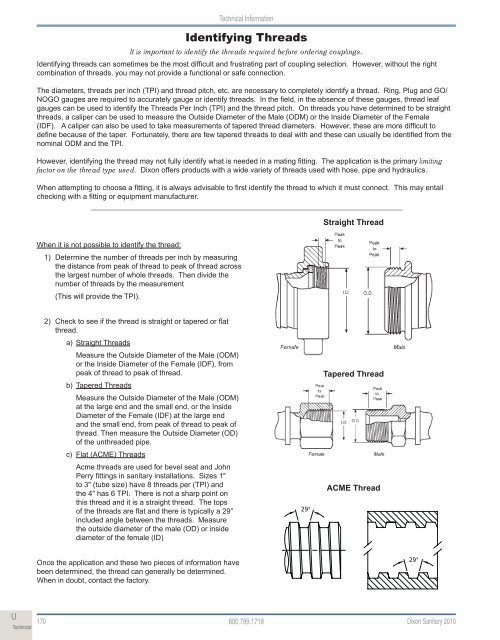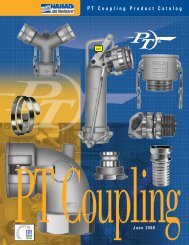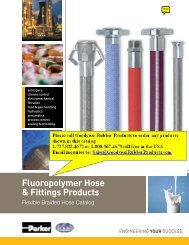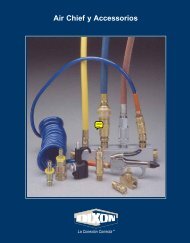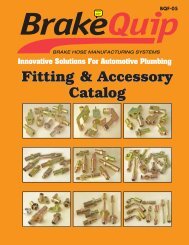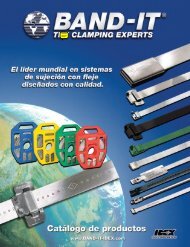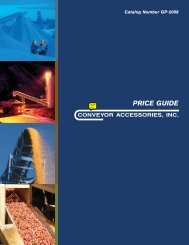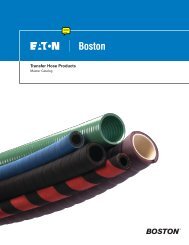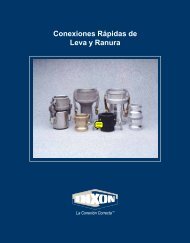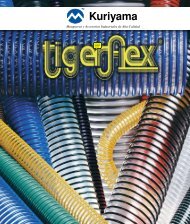Dixon Sanitary 2010 Catalog
Dixon Bradford Sanitary Division - Goodyear
Dixon Bradford Sanitary Division - Goodyear
- No tags were found...
You also want an ePaper? Increase the reach of your titles
YUMPU automatically turns print PDFs into web optimized ePapers that Google loves.
Technical Information<br />
Identifying Threads<br />
It is important to identify the threads required before ordering couplings.<br />
Identifying threads can sometimes be the most difficult and frustrating part of coupling selection. However, without the right<br />
combination of threads, you may not provide a functional or safe connection.<br />
The diameters, threads per inch (TPI) and thread pitch, etc. are necessary to completely identify a thread. Ring, Plug and GO/<br />
NOGO gauges are required to accurately gauge or identify threads. In the field, in the absence of these gauges, thread leaf<br />
gauges can be used to identify the Threads Per Inch (TPI) and the thread pitch. On threads you have determined to be straight<br />
threads, a caliper can be used to measure the Outside Diameter of the Male (ODM) or the Inside Diameter of the Female<br />
(IDF). A caliper can also be used to take measurements of tapered thread diameters. However, these are more difficult to<br />
define because of the taper. Fortunately, there are few tapered threads to deal with and these can usually be identified from the<br />
nominal ODM and the TPI.<br />
However, identifying the thread may not fully identify what is needed in a mating fitting. The application is the primary limiting<br />
factor on the thread type used. <strong>Dixon</strong> offers products with a wide variety of threads used with hose, pipe and hydraulics.<br />
When attempting to choose a fitting, it is always advisable to first identify the thread to which it must connect. This may entail<br />
checking with a fitting or equipment manufacturer.<br />
Straight Thread<br />
When it is not possible to identify the thread:<br />
1) Determine the number of threads per inch by measuring<br />
the distance from peak of thread to peak of thread across<br />
the largest number of whole threads. Then divide the<br />
number of threads by the measurement<br />
(This will provide the TPI).<br />
2) Check to see if the thread is straight or tapered or flat<br />
thread.<br />
a) Straight Threads<br />
Measure the Outside Diameter of the Male (ODM)<br />
or the Inside Diameter of the Female (IDF), from<br />
peak of thread to peak of thread.<br />
b) Tapered Threads<br />
Measure the Outside Diameter of the Male (ODM)<br />
at the large end and the small end, or the Inside<br />
Diameter of the Female (IDF) at the large end<br />
and the small end, from peak of thread to peak of<br />
thread. Then measure the Outside Diameter (OD)<br />
of the unthreaded pipe.<br />
c) Flat (ACME) Threads<br />
Acme threads are used for bevel seat and John<br />
Perry fittings in sanitary installations. Sizes 1"<br />
to 3" (tube size) have 8 threads per (TPI) and<br />
the 4" has 6 TPI. There is not a sharp point on<br />
this thread and it is a straight thread. The tops<br />
of the threads are flat and there is typically a 29°<br />
included angle between the threads. Measure<br />
the outside diameter of the male (OD) or inside<br />
diameter of the female (ID)<br />
29°<br />
Tapered Thread<br />
ACME Thread<br />
Once the application and these two pieces of information have<br />
been determined, the thread can generally be determined.<br />
When in doubt, contact the factory.<br />
29°<br />
U<br />
Technical<br />
170 800.789.1718<br />
<strong>Dixon</strong> <strong>Sanitary</strong> <strong>2010</strong>


